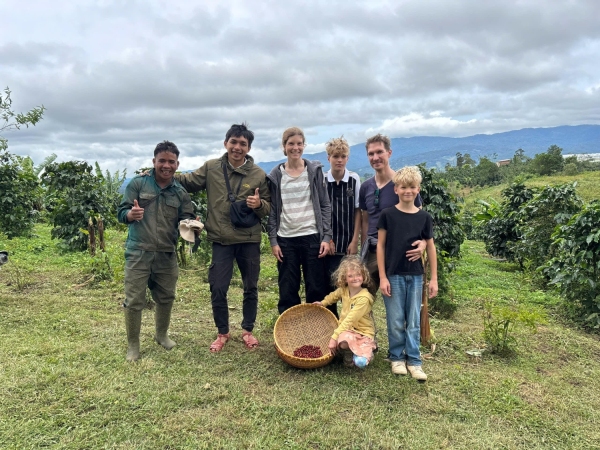
Bài tiếng Việt (Vietnamese version) có ở đây: Canh tác cà phê bền vững tại Đà Lạt: Hành trình từ đất đến ly | HuyEco.vn
Coffee is more than just a beverage—it’s a fruit grown in the highlands of Da Lat, Vietnam, at elevations of 1,200 - 1,600 meters. The flavor of coffee is shaped by how it's grown, harvested, processed, and roasted, making each cup unique.
Since 2017, HuyEco Coffee has been committed to sustainable coffee farming, embracing biodiversity, organic cultivation, and hand-picked harvesting with a near 100% ripeness rate. We manage every step, from planting to roasting, aiming to create a richer coffee experience while fostering sustainable development for farmers and the environment.

The Pan: Our First Roast
Before I started farming, I was used to instant coffee—it was cheap and convenient. But after our 2017 harvest, we had a problem: there was no facility nearby to process and roast coffee.
So, we took matters into our own hands.
We roasted our coffee on a wood-fired pan, experimenting with flavors that farmers—some with over 30 years of experience—had never explored. Ironically, these same farmers had always sold their coffee to large corporations, only to buy back instant coffee for their own consumption.
Curious about why our coffee tasted so different, we began our deep dive into coffee craftsmanship.



Understanding Coffee as a Fruit
With proper guidance, we hand-picked only 100% ripe cherries, something most farmers didn't do. The difference was staggering—the flavor, the texture, the quality.
Back when I was a student, I thought good coffee came from high-tech factories—modern labs with experts in white coats, just like in TV commercials.
But the reality?
A truly great cup of coffee begins on the farm.
Coffee must be picked ripe and processed the same day—or else it ferments and molds. We worked overtime to ensure proper processing, battling the cold nights of the Dalat plateau while pushing forward with passion.

The Colors of Coffee
You may have seen pictures of farmers harvesting coffee—but have you ever wondered how it works?
Coffee varies by species, ripeness, and quality.
✅ Ripe coffee cherries are usually red.
✅ Bourbon coffee can sometimes be yellow.
✅ Under-tree coffee appears deep red.
🚫 Green cherries mean unripe coffee—not ready for harvest.
Vietnamese coffee trees bloom only once per year, so the harvest happens every 10 months. But cherries ripen unevenly, requiring farmers to carefully hand-pick ripe ones while leaving green cherries for future harvests.
Of course, in a world where speed equals efficiency, workers often prioritize quantity over quality, leading to some green cherries being picked unintentionally. Over time, I've learned to accept this reality, knowing that perfection in coffee harvesting is a continuous journey rather than a single, flawless act.

From the Farm to Your Cup
Each stage—from hand-picking and processing to roasting and brewing—is an art that requires dedication. HuyEco Coffee is more than just a farm—it’s a commitment to sustainable, high-quality coffee production.
Through years of trial, error, and passion, we've learned that truly exceptional coffee isn't made in a factory—it’s crafted on the farm, shaped by nature, care, and hands that understand its delicate journey.
☕ Taste the Difference with HuyEco Coffee
Experience coffee grown with love, harvested with care, and roasted to perfection. Browse our Sustainable Coffee Collection and support ethical farming in Vietnam.
☕ If you’d like to taste coffee made the way I just described—from raised beds, from a cast-iron pan, from the hands of those who grew it—try a bag from HuyEco Farm.
👉 Order your coffee here
🌿 Or come visit us. Stand by the drying racks, smell the roast curling through the morning air, sip a cup brewed right where it was born. That’s what our farm tour is for.
👉 Book your eco coffee tour
📌 Internal Links
📌 Learn more about organic coffee processing 2024 - 2025
🔗 Read more about organic coffee processing at HuyEco
📌 Experience farm tours at HuyEco:
🔗 Explore HuyEco’s eco-friendly coffee tours
📌 How small-scale farmers sustain agriculture:
🔗 Sustainable farming techniques for small-scale coffee farmers
📌 External Links
📌 Report on organic coffee & fair trade:
🔗 Fair Trade Coffee Organization - Sustainable farming impact
📌 Insights from sustainable coffee organizations:
🔗 Rainforest Alliance - The future of sustainable coffee
📌 Research on regenerative agriculture benefits:
🔗 Regenerative Agriculture Report - Organic farming benefits
Reader Comments
Newer articles
 Sustainable Coffee & Local Culture Tour in Da Lat — Arabica, Robusta & Ethical Farming
Sustainable Coffee & Local Culture Tour in Da Lat — Arabica, Robusta & Ethical Farming
 Discover Sustainable Coffee in Da Lat — A Farm-to-Cup Journey with HuyEco
Discover Sustainable Coffee in Da Lat — A Farm-to-Cup Journey with HuyEco
 Sustainable Coffee and Local Farming Realities in Da Lat HuyEc
Sustainable Coffee and Local Farming Realities in Da Lat HuyEc
 From Forest to Cup: A Personal Journey into Sustainable Coffee in Da Lat
From Forest to Cup: A Personal Journey into Sustainable Coffee in Da Lat
 Inside HuyEco: How a Coffee Huller Machine Transformed Our Coffee Production
Inside HuyEco: How a Coffee Huller Machine Transformed Our Coffee Production
 From Forest to Cup: A Farmer’s Vision for Sustainable Coffee and Local Travel in Da Lat
From Forest to Cup: A Farmer’s Vision for Sustainable Coffee and Local Travel in Da Lat
 Field Notes from Xã Lát: Rooted in Regenerative Coffee & Indigenous Farming
Field Notes from Xã Lát: Rooted in Regenerative Coffee & Indigenous Farming
 Đưng K'Nớ: Brewing Sustainable Coffee in Vietnam’s Highland Forest
Đưng K'Nớ: Brewing Sustainable Coffee in Vietnam’s Highland Forest
 Living Coffee Ecosystem in Da Lat – HuyEco’s Way of Growing
Living Coffee Ecosystem in Da Lat – HuyEco’s Way of Growing
 Nel Drip & Wabi-Sabi: Japanese Coffee Rituals at HuyEco Da Lat
Nel Drip & Wabi-Sabi: Japanese Coffee Rituals at HuyEco Da Lat